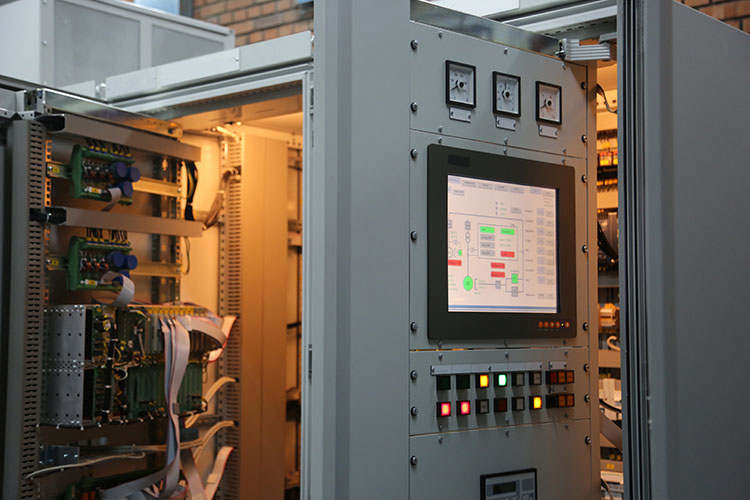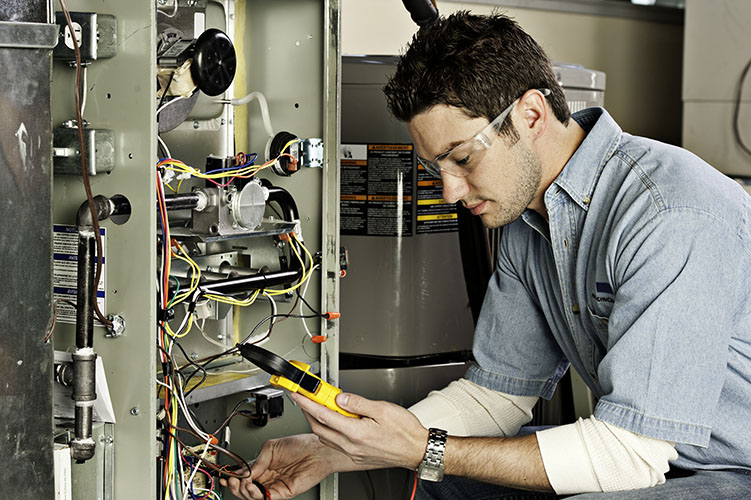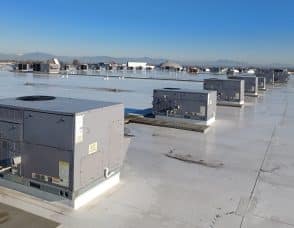Your Building Automation System Essential Guide: How It Works & Why You Need One
This article walks you through everything you need to know about a building automation system (BAS).
We start with what they are, and how they work. Next, we cover how this tech helps make facilities safer and more cost-effective—all while reducing facility management workloads.
And finally, because no conversation on connected devices is complete without discussing the Internet of Things (IoT, for short)—we even created a special IoT primer for you at the end of this article.
Need a quick answer? Jump to any section!
That’s totally ok. That’s why we laid out all the sections in the menu below to help you find what you need quickly.
…And if you’re looking for the full picture, you’ve also come to the right place, so read on!
What Is a Building Automation System (BAS)?
A building automation system (BAS) is a network designed to connect and automate certain functions inside a building. All of the building control systems, from lighting and HVAC (Heating, Ventilation & Air Conditioning) to fire and security systems—all wired through one set of controls.
Building automation systems (BAS) are often part of green buildings, too.
A smart building, also called an intelligent building, is one with a building automation system (BAS) in place.
What makes them smart is that the BAS helps maintain indoor air quality and energy efficiency by tracking the status of related systems. It doesn’t have to be just one building, either. If you manage a commercial property with multiple buildings, all of them can be managed through a single interface. This helps your facilities management team work smarter, not harder.

Building Automation System & Other Known Aliases
With more acronyms than alphabet soup, defining building automation systems (BAS) can seem tricky!
BMS, BACS, EMS, BEMS are just a few of the other acronyms floating around—and the list goes on! Some companies even assign different meanings to each.
Of All the Names, Why’d You Pick BAS?
First, some of these variations are simply regional preferences. Our team operates in North America, so we tend to follow ASHRAE’s lead—as the American Society of Heating, Refrigerating and Air-Conditioning Engineers.
- Just looking at a few heating, ventilation & air conditioning (HVAC) industry leaders:
- North American ASHRAE uses Building Automation Systems (BAS)
- Europe’s REHVA uses Building Automation and Control Systems (BACS)
- Australia’s AIRAH uses Building Management and Control System (BCMS)
Additionally, you have Building Management Systems (BMS) and Building Control Systems (BCS). However, there isn’t much difference between these two and Building Automation Systems (BAS). BAS is a more common term though, plus we like how BAS emphasizes automating processes as much as possible. Reducing hands-on supervision frees up valuable time and resources for other pressing concerns your company might be dealing with.
Finally, you may also hear it called an Energy Management System (EMS) or a Building Energy Management Systems (BEMS). Depending on who you ask, energy management systems can gather more in-depth data, which you can use to evaluate and adjust your building’s energy use.
In actual usage, many of these terms often refer to the same thing.
Each name for these systems may have a nuance making it just slightly different, but they all fall under the umbrella of centralized building automation, control, and management.

How Does a Building Automation System (BAS) Work?
For most building automation systems (BAS), input and output devices connect with a controller and a user interface. These components all work together to gather, process, and adjust information.
- Most BAS have five main components:
- Input devices (sensors): measure data (like CO2 in air and humidity)
- Controllers: the system’s “brain” decides how to respond to that data
- Output devices (actuators): carry out the controller’s programmed responses
- Communications protocols: a language for the parts to “talk” to each other
- User interfaces (UI): screens and dashboards to review building data reports
Input devices detect measurements like room temperature and whether equipment’s powered on. Output devices adjust these measurements, like reducing temperature or turning off equipment. The controller manages all the devices in a building’s primary systems, so it processes data from the input devices and sends any necessary changes to the output devices. These components have a shared language, or communications protocol, such as BACnet. The output devices carry out the controller’s commands according to programmed responses. For example, automatically increasing ventilation when CO2 is too high. Finally, the user interface displays data visually. This can be a computer, or even a web-based tool. But the user interface doesn’t need to actually run the controls; it just provides a single place for all of the readouts coming through the input devices.
But it’s actually easier than it sounds.
For example, when you want to adjust settings, your interface signals the individual system controls through the output devices and makes your adjustments. The building automation system (BAS) can link to the internet or just be internally connected—all depending on your property’s needs. Have a large portfolio with buildings in several cities, or a large campus with multiple buildings? An internet-connected BAS can unite them to give you centralized control.

What Are Building Automation systems, in HVAC?
We’ve heard this question many times.
Building automation systems (BAS) aren’t necessarily in heating, ventilation & air conditioning (HVAC)—just like they aren’t in security or lighting. A BAS simply unites those different systems under one set of controls so they can be centrally managed.
That said, building automation systems (BAS) are often associated with HVAC.
This might be because heating, ventilation & air conditioning (HVAC) systems are so embedded into buildings, while lighting and other systems can feel a little more surface level. Or maybe it’s because HVAC is one of those systems you don’t notice until there’s a problem, at which point you really, really notice it. Whatever the reason, a BAS allows for an incredible amount of HVAC automation.

Why Should I Care About Building Automation Systems?
For starters, building automation helps save money.
As an example, think about your building’s heat. In the summer, it may not be necessary to keep the building at a comfortable room temperature when there’s no one there.
You can set specific start and end times for your building’s normal temperatures, based on your occupants’ arrival times. If people typically leave at 9:00 pm and arrive the next day at 7:00 am, you can set a lower temperature in between to reduce energy use and costs. This option may or may not be already available to you, depending on what your heating, ventilation & air conditioning (HVAC) system looks like.
Your building automation system (BAS) can be even more responsive. Let’s say you decided to keep the temperature in your building at 24ºC (75ºF). An input device detects a reading of 22ºC (72ºF) in a particular space. This data runs through the controller, which notices the temperature is too low. It then signals the output device in that space to raise the temperature by two degrees, and it does. You can watch all of this through the user interface.

What Can I Do With Building Automation?
In addition to saving you money, there’s also so much more to these systems!
Building automation systems (BAS) don’t have to be “set and forget.”
Want to get insights about what’s going on in your building, how you can improve your automation settings, and how you can apply the data you discover? Go a step further and add IoT to the mix—for more about this, check out our special section at the end of this article, dedicated to the Internet of Things (IoT).
You can gather data about indoor air quality, temperature, humidity, security threats, and mechanical failures, then make corresponding adjustments to the system. For example, building automation provides real-time alerts—and automatically corrects issues like indoor pollutants and ventilation levels. Automated safeguards like these are why certification programs like the Indoor Air Quality Awards often require a building automation system (BAS) to qualify for the highest award levels.
Your BAS can even connect to your enterprise resource planning (ERP) software to help guide your business decisions.
When your systems integration is done right and paired with the proper tools, your BAS won’t just control your building’s thermostat settings or turn lights on and off. It’ll uncover inefficiencies and areas for improvement.

How Can Building Automation Improve My Facility & Reduce My Workload?
Building and facility managers face plenty of challenges, but five of the big ones are cost management, building safety and indoor air quality, building security and emergencies, environmental impact, and last but never least, user comfort. Building automation systems (BAS) address all these concerns.
1. Cost Management
If operational costs keep you up at night, a building automation system (BAS) might be the answer. Less energy means a lower power bill. Because you’ll be able to track how your systems are performing at any given time, you’ll also know exactly what needs to be repaired and when. That translates to lower maintenance costs, too.
A BAS simplifies managing large real estate portfolios. Whether you have an entire facilities management team handling your buildings or just a few strategically placed workers, they’ll be able to use their time and resources more efficiently.
Not sure if there’s room in the budget for a BAS? The cost savings often help pay for it. Plus, there may be local financial incentives for projects that reduce your facility’s carbon footprint.

2. Building Safety: Indoor Air Quality
Poor indoor air quality was a common, costly, and underestimated threat to building occupants—long before the current realities of a global pandemic.
Because building automation systems (BAS) can automate indoor air quality monitoring, this core feature becomes an important safeguard to help you improve indoor air quality for the safety of your occupants.
As building managers and owners, we’re legally responsible for keeping carbon monoxide and carbon dioxide levels within safe limits. Further, as we navigate 2021 and beyond, it’s increasingly falling to building managers and owners to limit indoor pollutants and pathogens (like the novel coronavirus/COVID19) from spreading through our heating, ventilation & air conditioning (HVAC) systems.
What does this have to do with BAS? For starters, if carbon monoxide reaches unsafe levels, your BAS can send you an alert and automatically activate the ventilation system to start pumping fresh air. That’s why the Indoor Air Quality Awards program requires a BAS at the highest certification level.
3. Building Security Threats & Emergencies
We’ve already mentioned how a building automation system (BAS) can integrate with your security system to automate threat responses. For example, if a motion sensor flags activity but none of the building’s tenants has swiped a security card, your BAS can determine there could be an intruder. It can then kick off a predefined security response to help protect your building.
Think about how your building automation system (BAS) would work during a fire. An activated smoke detector triggers a fire response. For example, emergency lighting turns on throughout the building, alarms blare, and prerecorded safety messages tell people to evacuate. At the same time, the BAS can prompt the heating, ventilation & air conditioning (HVAC) system to manage smoke by bringing in fresh air. It can also send data to first responders to help locate the fire’s source.
In these and just about any other possible emergency, a BAS can help you better protect your building occupants.

4. Environmental Impact
CO2 emissions are rising for many reasons, some of them relating to how buildings use heating, ventilation & air conditioning (HVAC) systems.
Air conditioning alone accounts for roughly 8.5% of worldwide electricity use. Canada has higher and lower temperature extremes than most countries, so our buildings have to compensate for those extremes. That’s just one reason why energy accounts for 82% of Canada’s total emissions.
On top of that, did you know 42% of all energy produced worldwide goes toward buildings? And did you know that 50% of that total energy is wasted due to inefficient building automation systems (BAS)? In other words…
21% of all energy produced worldwide goes towards waste energy for buildings — most of which could be recouped with more efficient building automation, control, and management.
We’re still looking forward to 100% efficient systems, so until then, waste energy remains a reality we have to contend with.
With a BAS in place, however, you can improve the performance of your heating, ventilation & air conditioning (HVAC) and other systems. This helps reduce waste energy as much as possible and may help meet your business’ environmental goals. You may even be able to earn your building the coveted LEED® certification.

5. User Comfort
It’s important to ensure the comfort of everyone using your commercial property. The temperature should ideally be 20–26ºC (68–79ºF), allowing for seasonal changes, with a relative humidity of 40–50%. With a building automation system (BAS) tracking temperature and humidity, building tenants will be more comfortable and even more productive.
Happy tenants tell friends and colleagues how much they like their space. This high level of satisfaction can lead to a higher referral rate, a lower vacancy rate, and better sales for your commercial development.

How Can I Make My BAS Work for Me?
Maybe you already have a building automation system (BAS) set up for your commercial development. If it’s working well for you, that’s great! We hope it’ll prove effective for a long time. If it’s not particularly successful, though, you might be frustrated and wonder if there really are any benefits of building automation systems.
There are several reasons why your BAS might not be working well for you. For example, it could have a poor user interface without easy data access, or it could simply be too old to integrate properly with your business’ systems. You can get around this by either upgrading or retrofitting your existing system, depending on what challenges you’re facing.
It’s also possible you need more support from your BAS provider to help you unlock all of its features. Even the most advanced BAS in the world will only make a difference if its building manager fully understands how to use it. Of all the buildings currently using BAS, only a meager 20% are using 80% of the system’s potential.
The takeaway here is that if you aren’t happy with your existing building automation system (BAS), talk to your local heating, ventilation & air conditioning (HVAC) service provider to learn how you can work together to optimize your system.

Level Up: BAS & the Internet of Things (IoT)
No conversation on connected devices is complete without discussing what building automation systems (BAS) have to do with the Internet of Things (IoT). This final section provides a quick overview of the bigger picture for you.
The Internet of Things essentially describes devices able to relay information remotely. While these devices, or “dumb items,” range in complexity, they aren’t particularly “smart“ on their own. Their controls can range from basic to complex—but the devices can’t manage those controls themselves.
Most importantly, for our purposes here today, think of IoT as a tool you can use to optimize your BAS.
What Does IoT Look Like?
Short answer: Rest assured, it’s less like The Matrix than you’d think!
In your home, there are many small tasks you’re used to doing every day. For example, you turn on your TV with your remote control, switch off the light when you go to bed, and close your garage door when you leave the house.
Now, all of the devices associated with these basic tasks can be connected to a smart speaker like Amazon Alexa, Google Home, or Apple HomePod. With just a voice command or a quick motion in the app, you can complete these tasks in one place—even if you aren’t at home. Not sure if you remembered to arm your security system or close your garage door? You can check on your phone and fix the problem in just a few moments.

How Does IoT Apply to Commercial Development?
For commercial building automation systems (BAS), IoT connectivity looks very similar. Picture a light switch. It’s common, reasonably efficient, and managed by people using a space. But it only needs to be on when someone is physically within that space, and they can forget to turn off the light when they leave. You can install motion sensors and connect them to the building’s lighting system. When a worker enters the space, the lights come on. When they leave, the lights go off.
If you want to manage the system even more closely, you can. Let’s say you connect your building security system with your lighting system, all through your BAS. The building automation system (BAS) detects the security system is armed, meaning no one should be left in the building. However, it also sees there’s still a light on in one of the offices. As a result, you get an alert about the situation so you can see what’s going on.
Why Do Smart Buildings Use IoT?
Turning dumb items into smart devices can reduce the workload of essential building systems that aren’t quite as necessary when people aren’t around. There are many systems running alongside each other, some of them interconnected, and it’s a lot of data for your facilities management team to monitor. This is especially true if you manage more than one building and don’t have the resources to do it all on-site and in person.

Are IoT Building Control Systems Secure?
You might have heard some concerns about IoT system security. IoT devices are internet-connected, so like many other connected systems we use every day, it’s possible for them to be hacked. However, it’s just a matter of approaching IoT with a security-first mindset for your building. Choosing your devices carefully and training your staff to use tech security best practices is often enough to reduce these risks—but of course, every operation differs in context, sensitivity, and susceptibility. Always do your research and connect with expert mechanical contractors who can help walk you through what suits your scenario.
We Can’t Wait To Hear From You!
Still have questions about building automation systems (BAS)? We’re always eager to help you learn more about systems and technologies that can make your business even more effective, so head down to the comments section and ask away.
*Please note: Gateway Mechanical doesn’t endorse any of the companies or products listed or linked to in this article, and we aren’t paid or otherwise compensated for mentioning them.









